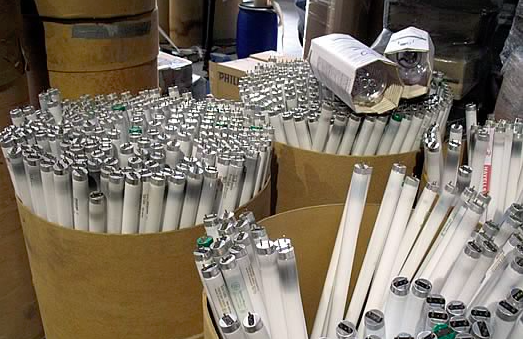Tri Valley Recyclers will pick up your Fluorescent Bulbs in a fee based service for businesses. DTSC Managing Waste Fluorescent Bulbs and Other Mercury-Containing Lamps.
Fluorescent tubes and other mercury-containing lamps become hazardous wastes when they no longer work. Non-working tubes must be recycled by an authorized recycling facility—they cannot be discarded with your regular household trash. When discarding your waste lamps, there are several options for getting them to an environmentally-safe and responsible universal waste or household hazardous waste (HHW) facility.
Mercury-containing lamps be managed as universal wastes under chapter 23 of title 22 of the California Code of Regulations. This allows people to handle waste fluorescent tubes and other mercury-containing lamps under a set of more relaxed management standards compared to other types of hazardous waste.

EPA recommends that consumers take advantage of available local options for recycling CFLs, fluorescent bulbs and other bulbs that contain mercury, and all other household hazardous wastes, rather than disposing of them in regular household trash.
Benefits of Recycling CFLs
Recycling prevents the release of mercury into the environment. CFLs and other fluorescent bulbs often break when thrown into a dumpster, trash can or compactor, or when they end up in a landfill or incinerator. Learn more about CFLs and mercury.
- Other materials in the bulbs get reused. Recycling CFLs and other fluorescent bulbs allows reuse of the glass, metals and other materials that make up fluorescent lights. Virtually all components of a fluorescent bulb can be recycled.
Your area may prohibit disposal and/or require recycling. Some states and local jurisdictions have more stringent regulations than U.S. EPA does, and may require that you recycle CFLs and other mercury-containing light bulbs. Visit search.Earth911.com to contact your local waste collection agency, which can tell you if such a requirement exists in your state or locality. We are aware that the following states prohibit mercury-containing lamps from being discarded into landfills. The following links exit the site:
Wastes Banned From the Trash
Many common products that we use in our daily lives contain potentially hazardous materials and require special care when disposed of. It is illegal to dispose of hazardous waste in the garbage, down storm drains, or onto the ground. Chemicals in illegally disposed hazardous waste can be released into the environment and contaminate our air, water, and possibly the food we eat. And by throwing hazardous waste in the garbage, you can cause additional hazards to your garbage handler.
Regulations to protect public health and the environment have been changing. This is because we now know that some common items that have traditionally been thrown in your household’s or small business’ trash cannot be safely disposed in landfills. These common items are referred to as hazardous waste, and some of them as “universal waste” (u-waste). As of February 9, 2006, all “u-waste” items are banned from the trash. For additional information on u-waste, please check the Department of Toxics Substances Control (DTSC) Web site.
The bottom line is that we must keep hazardous materials out of the trash by bringing them somewhere to be recycled or safely disposed such as a household hazardous waste collection facility. Check with your local waste management agency to find out where to take these items in your area.
Lights, Batteries, and Electronics
- Fluorescent lamps and tubes. Includes fluorescent tubes, compact fluorescent lamps, metal halide lamps, and sodium vapor lamps. LED lights should not be placed in the trash because they often contain metals in amounts that exceed threshold limits. For more information on LED lights, visit DTSC’s Regulatory Assistance webpage.
- Batteries. Includes all batteries, AAA, AA, C, D, button cell, 9-volt, and all others, both rechargeable and single use. Also lead-acid batteries such as car batteries.
- Computer and television monitors. Most monitors are currently considered hazardous waste when they have lived their life and are ready for recycling or disposal, including cathode ray tube (CRT), liquid crystal diode (LCD), and plasma monitors. Learn about the State program to offset the cost of proper television and monitor recycling.
- Electronic devices. Includes computers, printers, VCRs, cell phones, telephones, radios, and microwave ovens. Refer to “How do I know if a particular electronic device can’t be thrown in the trash?” for more information.
Mercury-Containing Items
- Electrical switches and relays. These typically contain about 3.5 grams of mercury each. Mercury switches can be found in some chest freezers, pre-1972 washing machines, sump pumps, electric space heaters, clothes irons, silent light switches, automobile hood and trunk lights, and ABS brakes.
- Thermostats that contain mercury. There is a mercury inside the sealed glass “tilt switch” of the old style thermostats (not the newer electronic kind).
- Pilot light sensors. Mercury-containing switches are found in some gas appliances such as stoves, ovens, clothes dryers, water heaters, furnaces, and space heaters.
- Mercury gauges. Some gauges, such as barometers, manometers, blood pressure, and vacuum gauges contain mercury.
- Mercury thermometers. Mercury thermometers typically contain about a half gram of mercury. Many health clinics, pharmacies and doctor’s offices have thermometer exchange programs that will give you a new mercury-free fever thermometer in exchange for your old one.
- Mercury-added novelties. Examples include greeting cards that play music when opened; athletic shoes (made before 1997) with flashing lights in soles; and mercury maze games.
